
The conversion occurred at room temperature and pressure, which could allow methane, a potent greenhouse gas, to be utilized to make fuel.
The new method converts methane gas into liquid methanol.
A team of researchers has successfully converted methane into methanol using light and scattered transition metals such as copper in a process known as photo-oxidation. The reaction was the best achieved to date for converting methane gas into liquid fuel at ambient temperature and pressure (25 °C and 1 bar, respectively), according to a study published in the journal Chemical Communications.
The term bar as a pressure unit comes from the Greek word meaning weight (baros). One bar equals 100,000 Pascals (100 kPa), close to the standard atmospheric pressure at sea level (101,325 Pa).
The study’s findings are a crucial step toward making natural gas accessible as a source of energy for the production of alternative fuels to gasoline and diesel. Despite the fact that natural gas is a fossil fuel, its conversion into methanol produces less carbon dioxide (CO2) than other liquid fuels in the same category.
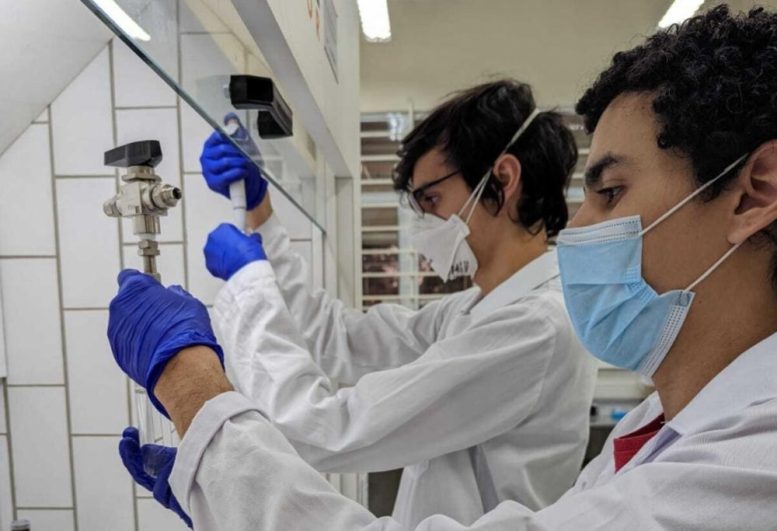
The conversion took place under ambient temperature and pressure conditions, which could enable methane, a potent greenhouse gas, to be used to produce fuel. Credit: UFSCAR
Methanol is vital in biodiesel production and the chemical industry in Brazil, where it is used to synthesize a variety of products.
Furthermore, methane collection from the atmosphere is critical for mitigating the negative consequences of climate change since the gas has 25 times the potential to contribute to global warming as CO2, for example.
“There’s a great debate in the scientific community about the size of the planet’s methane reserves. According to some estimates, they may have double the energy potential of all other fossil fuels combined. In the transition to renewables, we’ll have to tap into all this methane at some point,” Marcos da Silva, first author of the article, told Agência FAPESP. Silva is a Ph.D. candidate in the Physics Department of the Federal University of São Carlos (UFSCar).
The study was supported by FAPESP, the Higher Research Council (CAPES, an agency of the Ministry of Education), and the National Council for Scientific and Technological Development (CNPq, an arm of the Ministry of Science, Technology, and Innovation).
According to Ivo Freitas Teixeira, a professor at UFSCar, Silva’s thesis advisor and the last author of the article, the photocatalyst used in the study was a key innovation. “Our group innovated significantly by oxidizing methane in a single stage,” he said. “In the chemical industry, this conversion occurs via the production of hydrogen and CO2 in at least two stages and under very high temperature and pressure conditions. Our success in obtaining methanol under mild conditions, while also expending less energy, is a major step forward.”
According to Teixeira, the results pave the way for future research into the use of solar energy for this conversion process, potentially reducing its environmental impact still further.
Photocatalysts
In the laboratory, the scientists synthesized crystalline carbon nitride in the form of polyheptazine imide (PHI), using non-noble or earth-abundant transition metals, especially copper, to produce active visible-light photocatalysts.
They then used the photocatalysts in methane oxidation reactions with hydrogen peroxide as an initiator. The copper-PHI catalyst generated a large volume of oxygenated liquid products, especially methanol (2,900 micromoles per gram of material, or µmol.g-1 in four hours).
“We discovered the best catalyst and other conditions essential to the chemical reaction, such as using a large amount of water and only a small amount of hydrogen peroxide, which is an oxidizing agent,” Teixeira said. “The next steps include understanding more about the active copper sites in the material and their role in the reaction. We also plan to use oxygen directly to produce hydrogen peroxide in the reaction itself. If successful, this should make the process even safer and economically viable.”
Another point the group will continue to investigate relates to copper. “We work with dispersed copper. When we wrote the article, we didn’t know whether we were dealing with isolated atoms or clusters. We now know they’re clusters,” he explained.
In the study, the scientists used pure methane, but in the future, they will extract the gas from renewables such as biomass.
According to the United Nations, methane has so far caused about 30% of global warming since the pre-industrial age. Methane emissions from human activity could be reduced by as much as 45% in the decade ahead, avoiding a rise of almost 0.3°C by 2045.
The strategy of converting methane into liquid fuel using a photocatalyst is new and not available commercially, but its potential in the near term is significant. “We began our research over four years ago. We now have far better results than those of Professor Hutchings and his group in 2017, which motivated our own research,” Teixeira said, referring to a study published in the journal Science by researchers affiliated with universities in the United States and the United Kingdom, and led by Graham Hutchings, a professor at Cardiff University in Wales.
References:
“Selective methane photooxidation into methanol under mild conditions promoted by highly dispersed Cu atoms on crystalline carbon nitrides” by Marcos A. R. da Silva, Jéssica C. Gil, Nadezda V. Tarakina, Gelson T. S. T. Silva, José B. G. Filho, Klaus Krambrock, Markus Antonietti, Caue Ribeiro and Ivo F. Teixeira, 31 May 2022, Chemical Communications.
DOI: 10.1039/D2CC01757A
“Aqueous Au-Pd colloids catalyze selective CH4 oxidation to CH3OH with O2 under mild conditions” by Nishtha Agarwal, Simon J. Freakley, Rebecca U. McVicker, Sultan M. Althahban, Nikolaos Dimitratos, Qian He, David J. Morgan, Robert L. Jenkins, David J. Willock, Stuart H. Taylor, Christopher J. Kiely and Graham J. Hutchings, 7 September 2017, Science.
DOI: 10.1126/science.aan6515

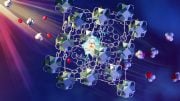


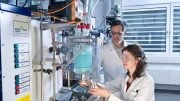
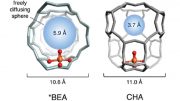
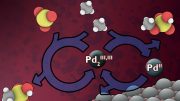


This isn’t the first time that photo-catalytic conversion of CO2 has been reported. The question that never seems to be answered, let alone even asked, is how expensive the process will be. It might just be cheaper to burn the methane, meaning that the resulting energy is more cost effective.
Methan gas is already a fuel source in it’s gaseous state, effectively liquifying it to condense it’s energy capacity is hardly a game changing scientific discovery…
This is a perfect example of a bad science backed article using keywords in a title as click bate.
Does SiTechDaily simply publish press releases, or is there staff capable of asking the obvious questions about them? In this case, conversion of gaseous methane into liquid methanol simply turns one greenhouse gas into a different one. Methane is highly active in the warming of the planet, but natural processes remove it from the atmosphere, so its long-term effect is weak. Converting methane into methanol and then burning the methanol as fuel for industrial purposes will result in the release of carbon dioxide into the atmosphere. Carbon dioxide remains in the atmosphere for a very long time, so the long-term effect on global warming is stronger.
The headline (written by SciTechDaily staff or copied from the press release) is misleading, because it gives the impression that global warming could be rolled back by “converting greenhouse gas into fuel.”
This is just another promotional article, likely driven by the source press release. They did achieve an advanced catalytic process. Still, the thermodynamics requires that more energy will needed to be input into the reaction to create higher carbon fuel sources that will then send the CO2 into the atmosphere when burned. Currently there are no proposals to extract the low concentration of CH4 from the atmosphere which would require the expenditure of much energy.
Such researchers operate in a fantasy world regarding how much time we have left to turn things around. Search for the following articles.
UN chief: World has less than 2 years to avoid ‘runaway climate change’ (TheHill) (Statement made over 4-years ago)
IPCC report: ‘now or never’ if world is to stave off climate disaster (TheGuardian)
Some farms around me already use methane gas to power their operation and with CO2 as a byproduct, they needs to be a way to capture that and put it to use. As currently there is a shortage of compressed CO2, the problem isn’t just getting rid of one to only convert to another but that the other is still a problem and could be used, stored or pressed underground. During mining operations and land clearing for development there is large amounts of carbon released into the environment, but we tend to only focus on cars and industries.